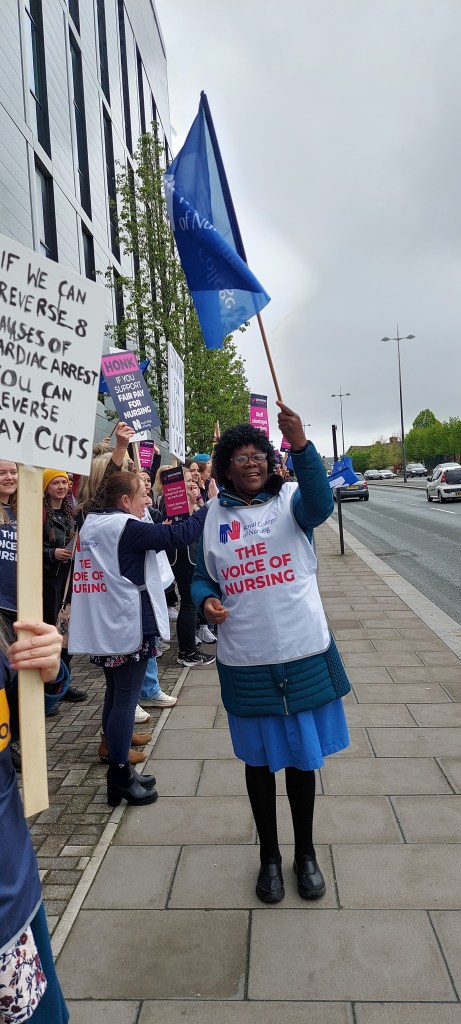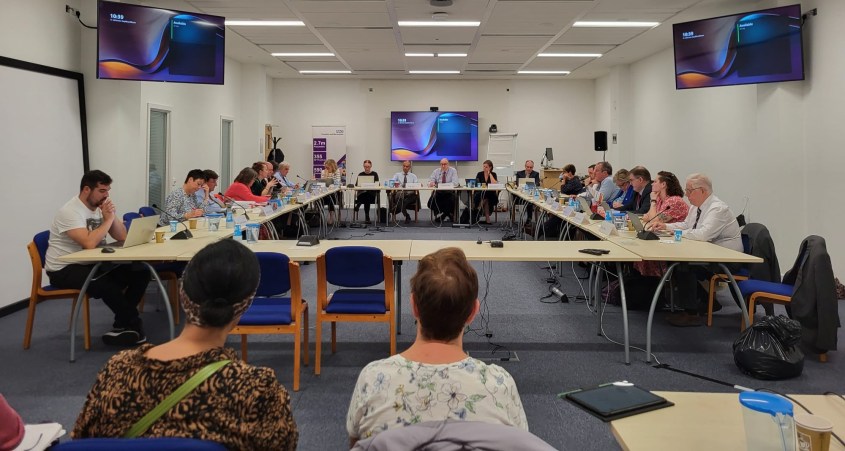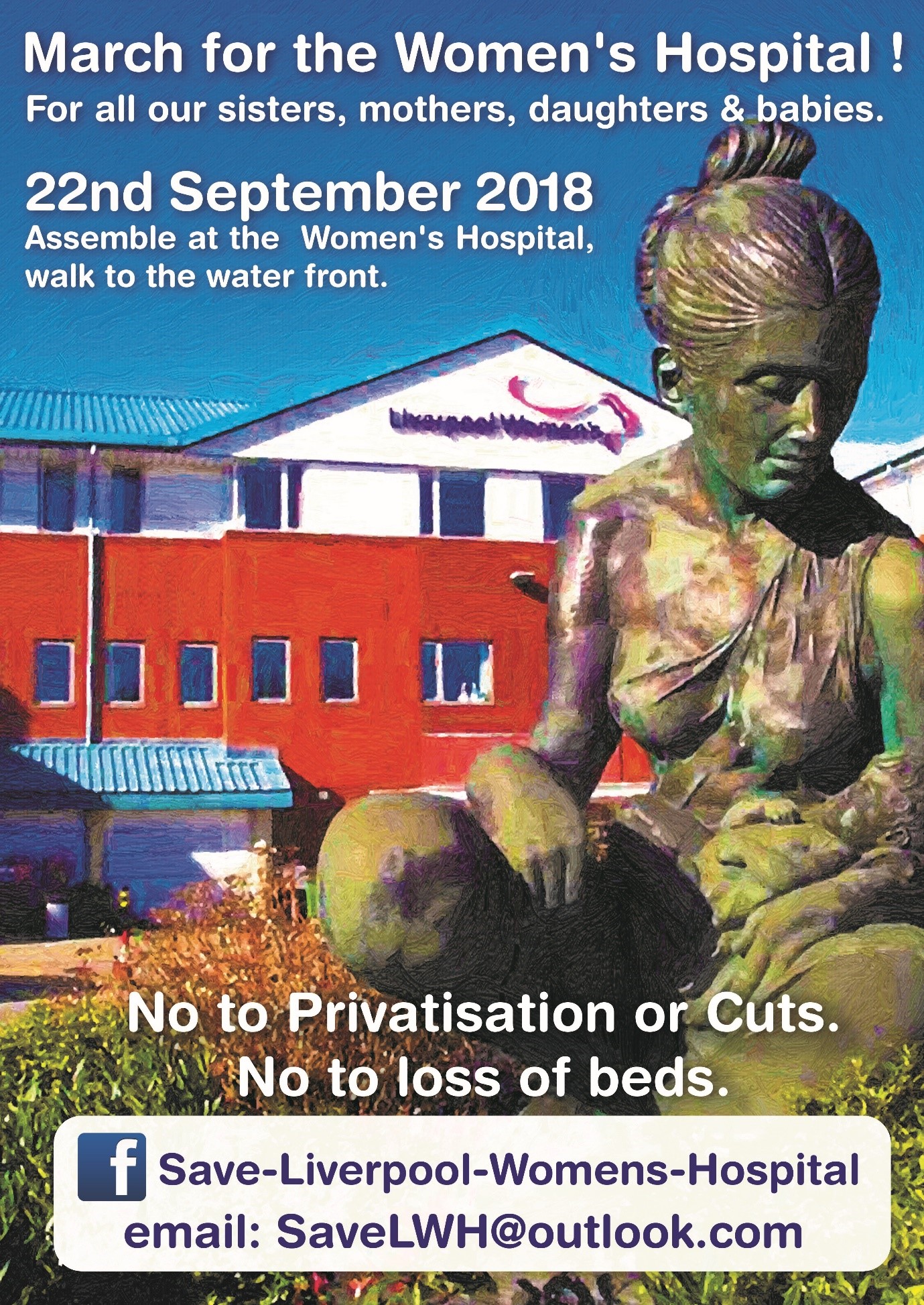
Women’s Hospital Foundation Trust Board has announced that it is to have a Joint Chief Executive Officer (CEO) with The Liverpool University Hospitals Foundation Trust. A joint CEO would often lead to a merger. They say this is an interim measure.
We have had a women’s hospital in Liverpool since 1796, but few remain in England. Most women’s care is provided in general/ acute hospitals.
There are serious issues for all NHS services in Cheshire and Merseyside and this attempt to fundamentally change Liverpool Women’s Hospital is part of the general attack on our services. It’s no surprise that the attack is aimed at Women’s Services and services for our thousands of babies born at Liverpool Women’s Hospital. We know that the site is very valuable to developers but its peaceful setting is also good for our health.
When we presented our petition to the Cheshire and Merseyside Integrated Care Board last February, we were told we would be kept informed and that there would be public consultation if significant changes were to take place. The move to a joint CEO seems to have bypassed consultation.

This move to a shared CEO (which normally leads to a merger) makes a mockery of all the promises of consultation with the public, with women and men who need the service. So, our campaign has become more urgent. Please talk to family friends, and workmates about what’s happening in our NHS. Those conversations are what change the world. We can and must win back the NHS and only popular pressure will do that. Please share this article, and sign our petition if you have not done so already. Please come to our demonstration.
This move on the future of the Liverpool Women’s Hospital makes our demonstration on October 7th still more urgent. Please come, bring your family and friends and banners, and make your placards.
So what has gone on?
Instead of the promised public consultation on the future of the hospital, this pre-merger has been done by fiat.
The managers of the NHS forget that our healthcare is a public service and the public will have a say, whether they are invited to do so or not.
Our petition
Both our online and paper petitions say “Save the Liverpool Women’s Hospital. No closure. No privatisation. No cuts. No merger. Reorganise the funding structures, not the hospital. Our babies and mothers our sick women deserve the very best”.
There are more than 73,000 signatures on our petition, 43,700 online, and the remainder on paper (and the count is verified). To get an idea of the scale of this petition, the new, enlarged, Anfield stadium will hold 61,000 people, and Everton will hold 52,888. Our petition, online and on paper involves 73,00 and growing. This seems to matter nothing to the NHS managers.
We are not accepting this lying down. It is not too late to stop this. We will not sit by and see cuts to the services for women and babies. We have seen in report after report, not least the recent Nottingham report, the damage to our maternity services and how it costs tiny lives.
Why do we oppose this move to a shared CEO?
The hospitals and other aspects of healthcare are facing an appalling winter as cuts and staff shortages bite ever deeper. The damage done by the last two Health and Care Acts is becoming sickeningly clear. It appears that the purpose of the ICB system is to close hospitals and deny care. We have been told by those intent on cuts for many years that Liverpool has too many hospitals. It is not just happening in Cheshire and Merseyside.
Closing hospitals and reducing bed numbers is a standard response to financial problems imposed by the Government. Yet this costs lives
Maternity crisis
The use of a shared CEO will do nothing to address the maternity crisis. It will do nothing to solve the chronic underfunding of maternity services.
Day by day, night by night, in Liverpool Women’s Hospital and other maternity hospitals we have a shortage of midwives, obstetricians, and nurses. The CQC reports across the country show this. This government chooses not to fund maternity to the standards required to keep the service safe. Hence the many scandals and reports. We demand a change in funding for maternity, for all our mothers, sisters, daughters, friends, and lovers, and for all the babies. We know all too well the dangers of the situation in maternity but the recent report from Nottingham underlines this.
Infant Mortality
Neither a merger nor a joint CEO will do anything to address the infant mortality rates in the UK which are worse than 39 other advanced countries. These figures are dreadful and these figures have got worse in the years of Austerity.
The Nuffield Trust said “The infant mortality rate fell from 6.3 deaths per 1,000 live births in 1993 to 3.9 in 2013 and the neonatal mortality rate fell from 4.2 deaths per 1,000 live births to 2.7 over the same time period. However, since then progress has stalled and even worsened slightly. In 2021, the infant mortality rate was 4 deaths per 1,000 live births, 0.1 more than what it was in 2013. Similarly, the neonatal mortality rate was 2.9 deaths per 1,000 live births, slightly higher than 2013’s record low. This corresponds to 2,374 infant deaths and 1,701 neonatal deaths in 2021.”
The Bliss neo-natal charity said, “The data also highlights the continuing health inequalities in risk of neonatal mortality – with Black babies, babies born to mothers under the age of 20, and babies born in the most deprived areas being at significantly higher risk.”



It will do nothing to improve services for women in the health service in the area covered by LWH. Liverpool Women’s Hospital is the area’s maternal medicine centre.
Liverpool Women’s Hospital is a Referral centre, a tertiary service for Cheshire and Merseyside. Patients come from North Wales and as far as the Isle of Man About 75% of patients come from the Liverpool region, the rest from further afield
Women are not prioritised in general hospitals. The standard emergency protocol for the use of operating theatres is “Life, Limb and Testicles” Think about it. Where are ovaries in this priority list?
Women’s Health
Even this dreadful government has recognized the issues for women’s health in a strategy reported last year. Women deserve better.
“This country’s health and care system belongs to us all, and it must serve us all. However, sadly, 51% of the population faces obstacles when it comes to getting the care they need. Although women in the UK on average live longer than men, women spend a significantly greater proportion of their lives in ill health and disability when compared with men. Not enough focus is placed on women-specific issues like miscarriage or menopause, and women are under-represented when it comes to important clinical trials. This has meant that not enough is known about conditions that only affect women, or about how conditions that affect both men and women impact them in different ways.“

Sharing a CEO will not improve the financial position of either of the hospitals involved. The Liverpool Women’s Hospital is significantly underfunded and was in deficit last year (according to ICB papers) to the extent that consultant cover overnight is affected. LWH faces severe financial problems this year, all directly from Government policy. Maternity nationally is underfunded but this hits Liverpool Women’s Hospital particularly hard because maternity accounts for eighty per cent of its budget.
In fighting for Liverpool Women’s Hospital, we are also fighting for maternity nationally.
Liverpool University Hospitals Foundation Trust has even greater financial problems, the worst in the ICB area, it has been at the government’s top level for financial “difficulties”, level 4. There are very real reasons why LUHFT required more funds than the stingy government allocation, not least its single-room design and the problems in the build of the hospital. Nationally most trusts have financial problems, caused in the main by poor funding and the leakage of funds into for-profit companies. Somehow “working together with a view to a merger “ will solve these issues? There is no mention in the announcement of extra funding. Show us the money!!

We stand in solidarity with everyone who works in LUHFT. We are not claiming one hospital is better than the other. We are saying that we need the Women’s Hospital.

Liverpool University Hospital Foundation Trust has had a troubled start and many of the problems have still to be sorted out, including, we are told, the women’s toilets in the new Royal and the leaking of 14,000 people’s salary details, cancer waiting lists and more. We fight for better funding, staffing and organizational arrangements for every hospital, but lumping these two hospitals together is unacceptable.
How can one man be CEO of two complex hospitals? There are major issues at LUHFT. The current CEO is in position because of reports like this;
“Ted Baker, chief inspector of hospitals, said “When we inspected services at Liverpool University Hospitals NHS Foundation Trust, we were concerned that the trust’s leadership team had a lack of oversight of what was happening on the frontline. “There were significant issues with patient access and flow through the emergency department and this was affecting the ability of staff to deliver safe care and treatment. We observed lengthy delays and poor monitoring putting patients at serious risk of harm. We were particularly concerned about how long people were waiting to be admitted onto medical wards and by the absence of effective processes to prioritize patients for treatment based on their conditions.”
This move towards merger ignores the responsibility and multiple promises to consult the public about major changes in health care.
If we want the NHS to be restored and repaired we must build a mass campaign. We are in the middle of a major assault on publicly funded, publicly provided, free at the point of need, well-funded healthcare in this country, and private profit is making a fortune. The health privatization lobby makes the Tobacco and Oil lobbies look like amateurs. This lobby has its grip in parts of Labour as well as the Conservative and dominates the narrative in much of the media.
Layers of management and control.
There are two main layers of management in the local NHS, the Integrated Care Board and the Hospital Trust Boards. The ICB holds the purse strings and supposedly decides policy for the area. Before the 2022 Health and Care Act, hospitals were supposed to act like separate companies, competing with each other. They are now supposed to work as a system but the legal powers of the trusts remain. This is the power the Hospitals have used to leap over public consultation.
Our Save Liverpool Women’s Hospital Campaign presented a bound copy of some of our signed petitions to the ICB earlier this year. It was well reported in the local press. The meeting was held to consider the Carnall Farrar report on the future of specialist services in Liverpool but mainly to rehash the arguments about the future of Liverpool Women’s Hospital. please see our earlier posts on this.
In a meeting with the chair and chief executive, we were told we would be kept informed of what was happening. We were invited to one meeting with the leading medics in the project and then we heard nothing. We asked for minutes of the Women’s subcommittee and from One Liverpool (the Liverpool place).
Last week we were invited to another meeting. The message inviting us that said
“We are really keen to ensure that you are kept up to date and are therefore offering this one-off meeting in order to provide you with an update as to where we are and to provide you with information as to our plans for setting up the formal groups, including the group by which we will be engaging patients and the public. Moving forwards it will then be via the formal group that we will be engaging and providing updates, and we will be looking to identify our patient and public representatives to sit on the engagement group with the support of Healthwatch.”
Five of our campaigners attended this meeting.
We raised issues about the staffing and financial problems at Liverpool Women’s and how the poor situation had meant that vital improvements had been shelved. We spoke about how nonrecurrent savings in 2022-23 have to be made good in 2023-24 from recurrent items and further CIPs (cuts in this year’s budget ). The hospital had lost funding it had previously received. We expressed our grave concerns that this was far more of a clinical risk than transferring about 8 women a year to Liverpool Royal for Intensive Care. Of course, intensive care must be improved, but other dangers were clear and present and seen in the CQC report.
The message we got in response was that things were moving through the Women’s Committee and the individuals that we were talking to were involved. We were given a paper copy of a letter from the Chair of the Integrated Care Board which said:
“It’s important to stress that at this stage no proposals have been made for how services might look in the future –”
In response to our query about mergers, (which was common talk amongst staff), this was denied. We asked about the item scheduled in Liverpool City Council Health and Adult Social Care Committee. The item was to decide if the issue of the future of Liverpool Women’s Hospital needed scrutiny. They claimed not to know about it.
The very next day the announcement was made about the shared CEO and specifically said it had been agreed by the ICB, whose deputy medical director was at this meeting with us. To say the least, this sham appeared to lack candour
Please support our campaign.
Who are we? Save Liverpool Women’s Hospital campaign is a group of campaigners who came together to protect Liverpool Women’s Hospital and to fight for a return to the original model of the NHS. We have attended Liverpool Women’s Hospital board meetings for many years. We have worked with other campaign groups in Cheshire and Merseyside and have attended the ICB meetings and read their papers. We run street stalls and attend events, lobby councillors and MPs. We link with trade unions and other campaigns for the NHS and women’s rights

What do we want?
A government-funded, national, universal, comprehensive, health service, publicly delivered, not for profit, free at the point of need as a coherent national service, with decently paid staff with a better focus on women’s health and babies’ health.


